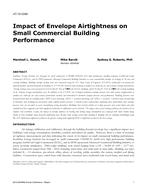Description
Southface Energy Institute has leveraged its small commercial (<50,000 ft2(4,645 m2)) high performance building program, EarthCraft Light Commercial (ECLC), and its DOE-sponsored Advanced Commercial Building Initiative to assess uncontrolled envelope air leakage in 38 new and existing buildings. Building envelope leakage rates were measured using the US Army Corps of Engineers (USACE) multi-point test protocol for depressurization and pressurization of buildings to ±75 Pa (0.3 inH2O) with masking of outdoor air, make-up air, and exhaust envelope penetrations. Average leakage rates were measured to be 0.25 cfm/ft2 (4.6 m3/h∙m2) for ECLC buildings and 0.74 cfm/ft2 (13.6 m3/h∙m2) for existing buildings in the Atlanta, Geogia metropolitan area. In addition to the USACE test, Southface performed envelope pressure tests with various configurations of outdoor air, make-up air, and exhaust penetrations masked and unmasked to determine damper presence and performance. Building pressures were measured while only air handling units (AHUs) were operating, AHUs + exhausts operating, and AHUs + exhausts + kitchen hoods all operating to determine most buildings do not operate under slightly positive pressure. Valuable lessons learned from conducting these multi-blower door envelope pressure tests are presented to assist streamlining testing procedures. Buildings that received retrofit air sealing measures were tested before and after completion of these upgrades and show significant reductions in infiltration can be achieved. The largest source of air leakage pathways was found to be in complex roof assemblies. Lastly, the impact of envelope tightness on heating and cooling energy consumption was analyzed with Open Studio energy models of three buildings using measured infiltration data. Results show savings varied from building to building, but the modeling methodology using BLAST infiltration coefficients resulted in the greatest savings while applying DOE-2 coefficients resulted in the least savings.
Product Details
- Published:
- 2015
- Number of Pages:
- 8
- Units of Measure:
- Dual
- File Size:
- 1 file , 1.8 MB
- Product Code(s):
- D-AT-15-C069
- Note:
- This product is unavailable in Russia, Belarus




